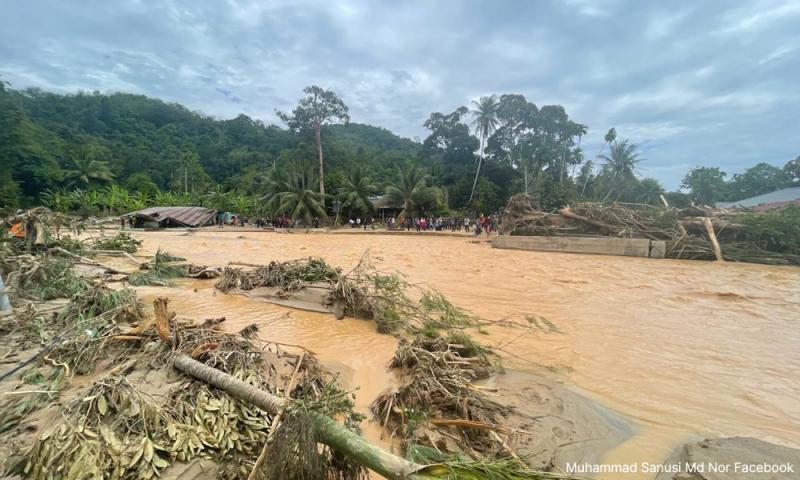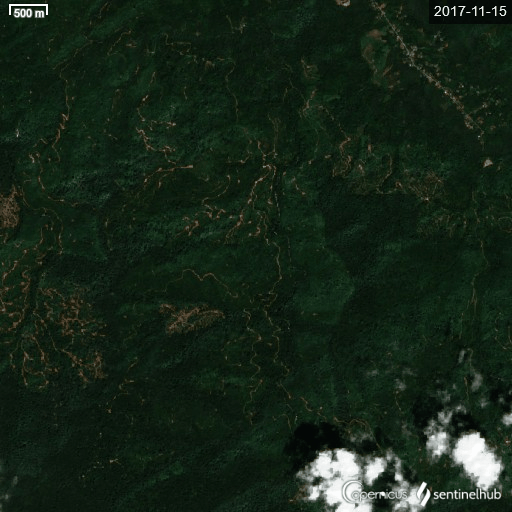The recent Baling 'flash floods' that saw the damage to property and even loss of life. What is the cause of this floods - the government ought to explain HONESTLY, and even take responsibility if the government is responsible in any way - hence an apology, and what they would do to compensate the victims.
Three lives were lost, and 1,400 residents had to be evacuated. How much was the total loss suffered by the people - tell us that. Do not simply tell us how much the government lost or spend after the fact? Is anyone going to be charged for MURDER or a lesser killing offence - as this must be done. God should not be blamed every time - and the persons by reason of their negligence, etc must be determined and prosecuted... ? Who is the government going to take action against - ...
They should go further and even explain what they will NOW do to make sure the area will not be flooded again come monsoon season.
After floods, our government comes out with plans for FLOOD MITIGATION - means the flooding in the future...or what will be done to mitigate(reduce) the possibility of flooding...
The current problem now is the direct responsibility lies with the LOCAL GOVERNMENT/Local Councils(but then we do not still enjoy the right to elect our own Local Government reps -they are all State(or Federal) appointees. Since the Baling Floods, have the Local Government responsible come out and provided explanations, taken responsibility or even told the people of Baling affected what would be done to make sure they do not fall victims to floods >>>I did not see any reported statement from the Local Government...why is that???
The other party responsible is the STATE GOVERNMENT - what have they done? Many statements have been how they were not responsible - that it was not due to illegal logging, or prior approvals given by State to people to clear forests - to plant durians. Was it because the State did not monitor water ways - and irresponsible loggers or farmers have let waste products(uprooted trees/plants and soils to enter and reduce the depth of rivers, or the State bodies had failed to effective monitor and enforce laws, ....There was lot of tree parts that washed out during this flood - should we not determine where it came from and who was responsible?
Maybe we need an INDEPENDENT BODY(not being persons from the affected Local Government or State government) to investigate and tell us the truth...maybe from the Federal government and other States...and many non-governmental experts, who will decide independently of the political parties in control.
Royal Commission of Inquiry(RCI) have had significant impacts in the past. The RCI on the Bright Sparklers incident saw the enactment of Occupational Safety and Health Laws. The RCI on police saw the improvements to the police force, and the call for the IPCMC (and independent body to monitor and investigate the police.
Do we need a RCI for the Baling Floods? The answer should be YES - but it is important that the RCI is open to the public, and the findings are made PUBLIC so all will know the TRUTH and the recommendations made on how we can improve matters >>> We do not want the RCI report and findings to be 'HIDDEN' from us as happened in the RCI on Wang Kelian >>> WHY...WHY...HAVE THE GOVERNMENT NOT MADE PUBLIC THE RCI ON WANG KELIAN YET?
Minister Wan Junaidi is saying NO to the RCI ...Why because after it makes the recomendations, cabinet just pick and choose what it wants...so, the problem really is not with the RCI but is a problem of a failure of Cabinet. If made public, the people can also decide what recomendations to push for if and when cabinet refuses to take up some(or all) recomendations of the RCI.
Wan Junaidi seems to point his finger of blame on LAW ENFORCEMENT... He said what was more important was to look at the existing aspects of law enforcement.
Well, that suggests that the law enforcement bodies failed in their duties of ensuring laws are obeyed, and taking action against the perpetrators > but would not a problem arise when the GUILTY may be the State and State GLCs > 'the project was to be implemented by Menteri Besar Kedah Incorporated and JV Kedah Agro Plantation Sdn Bhd at the early stage, and by Aman Mega Sdn Bhd.'
The one who approved the project was the State government - and was there a lack of enforcement because the 'guilty' may be the State government. Was there 'corruption' - MACC is apparently investigating. But to date, there seem to be no company, be it the GLC or MB Kedah Incorporated who have been charged... This is a problem that arises when the State makes laws, the State enforces the laws and government companies and GLCs are the perpetrators.
Elections coming - so this is also a factor that determines who get charged or blamed...another reason for an independent RCI..Have we heard of any action legally taken against MB Incorporated, government companies ... Government should stay out from direct involvement in business, and focus on laws and law enforcement for the benefit of the people - not government leaders or politicians. Was there an OPEN TENDER for this project? Was there an EIA - read ' Baling estate got environmental OK ‘for rubber, not durians’ - and what the the director-general of environment, Wan Abdul Latiff Wan Jaffar says.
FOREST RESERVE - maybe we need a new category - Forest Reserve For Flood Prevention/Mitigation. Yes, there are many kinds of 'Forest Reserve' - but information of what and where this different forest reserve is not easily available - as it can maybe be found in State Gazettes - which we find is not easily accessible online. Maybe there should be Forest Reserve for protection of Water Catchment areas, Forest Reserve for the Protection Endangered Wildlife, etc.. and importantly if a part of any forest reserve is to be changed to allow logging or durian plantations... the PUBLIC must be informed so that they can exercise their right in the decision making >> make the announcements ONLINE.
It looks like both the State and the Federal Government will just do nothing and hope people will forget when some other matter draws their attention away...
RCI, if truly independent persons are appointed, is a RISK to government as they might reveal the TRUTH to the people - and state governments cannot 'cover up'.... That is why a RCI is BEST - and then we will see what our poliitical/government leaders will do...and/or choose not to do...
In fact, there should be another RCI to look into the floods last December - to be tasked also on what need to be done to prevent future floods or reduce the impact of floods. After all, the government seems to have not told us of the concrete steps/actions that will be done by the respective States...the Federal Government...
WANG KELIAN will not be forgotten - and so please make public the REPORT. All RCI must be open to the public and reports/findings too.
No need for RCI on Baling floods, says Wan Junaidi

KUCHING, July 9 — There is no need to set up a Royal Commission of Inquiry (RCI) to investigate the floods and water surge phenomenon that hit several villages in Baling, Kedah on Monday, said Minister in the Prime Minister’s Department (Parliament and Law) Datuk Seri Wan Junaidi Tuanku Jaafar.
He said what was more important was to look at the existing aspects of law enforcement.
An RCI does not have specific powers but only able to submit proposals for government consideration, he said.
“RCI does not have the power to arrest (the offenders) but only make recommendations and their investigation will usually take six to seven months and the report will be tabled in the Parliament.
“Finally, the report will return to the Cabinet ministers for them to choose which proposals they want to implement,” he told reporters after the symbolic presentation of cows for the Aidiladha sacrificial slaughter for the Santubong parliamentary constituency here today.
The 4pm disaster claimed three lives while more than 1,400 residents had to be evacuated to three relief centres.
Meanwhile, commenting on the proposal for a special parliamentary session to discuss the issue of the price of goods, Wan Junaidi said it was not necessary.
He explained that this was because the Dewan Rakyat session would begin on July 18 and members of parliament could submit any motion during the sitting. —Bernama - Malay Mail, 9/7/2022
Baling estate got environmental OK ‘for rubber, not durians’

PETALING JAYA: A forest plantation project atop a hill in Baling alleged to be the cause of floods last weekend had been given approval to plant rubber trees but not for durians, the environment department said today.
It said the plantation was given environmental approval in 2013 for a forest plantation not exceeding 5,000 hectares (12,300 acres) as pollution prevention, mitigation and control measures were found to be adequate.
The approval was for logging and replanting, felling for planting latex timber clone and forest development of a mono-crop forest plantation for rubber wood and latex, the director-general of environment, Wan Abdul Latiff Wan Jaffar, said in a statement posted on Facebook.
However, the department found in March 2021 that durian trees had been planted instead of “timber latex clone” – rubber trees grown for both timber and rubber – and two other log varieties.
The department sent a compliance notice that month, it said. However, the department did not specify what orders were given to the plantation project owners.
He said the project was to be implemented by Menteri Besar Kedah Incorporated and JV Kedah Agro Plantation Sdn Bhd at the early stage, and by Aman Mega Sdn Bhd.
At the department’s most recent enforcement check on May 24, “we found no active logging or replanting of seedlings on the site”.
“There were also no active logging or replanting activities during the movement control order period to date as such activities were not approved. However, cover crops were planted over the exposed areas,” he said.
Wan Abdul Latiff said the department would continue to monitor activity on the hill to ensure environmental laws are adhered to.
Several villages in the Kupang area in Baling were hit by flash
floods following continuous rain on Monday, causing Sungai Kupang to
overflow. As a result, seven houses were washed away and about 70 others
were damaged. Over 1,000 people were displaced. - FMT, 9/7/2022
In God’s truth, what caused Baling’s deadly floods?
What’s happened to our senior PAS politicians? Have they suddenly seen the light or gone through some form of religious conversion?
In the past, when heavy rain caused flash floods and triggered land- and mudslides, Malaysians would react angrily against the government, both state and at national level.
Their demand for answers would be met with the usual response, “It’s an act of God, it has nothing to do with logging of the hill slopes.”
Few would dare to argue. The mention of God is a good tactic used by Malay politicians to silence their critics because no one likes to be reprimanded for “questioning” God, even if death and loss of property has taken place.
Following the deadly floods in Baling, Kedah, this week, Malaysians are again demanding answers about why they are occurring – and recurring – and about the lack of preparedness, the failure to warn the people, and the long wait before aid was mobilised.
Many villagers in the affected areas would have sounded alerts about various activities upstream, about how they feared these would cause flooding problems if not acted on by the authorities. Their fears, they would tell you, had fallen on deaf ears.
It was not the first time that they had experienced such disasters before. The trail of destruction left by the raging floodwaters in Gunung Jerai nearby last year must have been fresh on their minds.
In September last year, energy and natural resources minister Takiyuddin Hassan had denied allegations of illegal logging and told Parliament the disaster was an act of God.
In the wake of the Baling floods, he again dismissed claims that logging and the clearing of land to open up a vast durian plantation were the real causes of the incident. He rejected a call to set up a royal commission of inquiry, and denied claims that the relevant departments had dragged their feet when identifying the areas at risk.
So how does one explain to a non-scientist like Takiyuddin that man’s activities helped to accelerate the damage inflicted on the villages? In the pursuit of profit, our authorities think nothing about destroying the environment. We log our jungles without worrying about the consequences.
Is Takiyuddin aware that the canopy of huge trees in the jungle is a necessary natural deterrent against flooding? Trees act like a giant umbrella during heavy rain and their roots absorb much of the moisture. The rotting vegetation on the jungle floor also takes in some of the water run-off.
Replacing trees in the jungle with a crop like oil palm is insufficient to prevent flooding. The oil palm does not act like a sponge, as large trees would. They do not form a canopy and the space between each palm tree is large, causing rain to fall directly onto the soil. The rivers cannot cope with the excessive amount of water from the surface run-off.
Do irresponsible people who denude the forests and plant oil palm, or rows of Musang King durian trees, realise that there is bound to be future trouble? As there are few roots to hold the soil together, the hill slope becomes increasingly vulnerable when there is rain. Trees will be uprooted.
Will Takiyuddin listen? He claimed that the government and relevant departments gave priority and took action in areas identified as high risk for disasters, and that Gunung Inas – from where a gush of water had come – was not listed as a high-risk area before Monday’s tragedy.
Which areas were deemed high risk? Would environmental NGOs agree
with the state’s assessment? Try telling the affected villagers that
priority decisions had been made and action taken to prevent flooding.
No one would believe Takiyuddin. - FMT, 9/7/2022
Denuded hills cause of Baling floods
PEOPLE are being misled about the cause of the Baling floods. It is being claimed that “kepala air” or “headwaters” are the cause. This is far from the truth as headwaters are where rivers begin in the hills or mountains.
Naturally, when there is heavy or prolonged rainfall at headwaters, some of the water does not get absorbed into the ground as quickly as during normal rainfall. The excess water goes directly into the rivers, causing the levels to rise quickly and flow downstream at great speed and pressure.
People living in the hinterlands are well aware of how the rivers rise when there is heavy or prolonged rainfall in the upper reaches of the rivers. They never build their houses near or below the highest level of rivers during the so-called “kepala air” phenomenon. This is like the high-tide mark of the sea at any given point. No sane person will build a house on the ground below or close to the high-tide mark.
The houses that were washed away by the Baling floods were all above the highest mark of the river level and had stood there for years, decades or even longer without the gushing waters reaching them. When the forest in the heavy rainfall area upstream is intact, the gushing water is as clean as drinking water.
But what happened in Baling was a mudflow, albeit somewhat diluted mud. And the amount of water and mud that came gushing down was many, many times of the normal “kepala air”. Water levels went way above the normal highest-level mark and caused all the devastation.
The direct cause of the flood was the thousands of acres of barren or naked land, exposed directly to rainfall that loosened the soil and carried it down with the high run-off volume. The massive quantity of water flowing downhill at speed swept everything in its way.
Sahabat Alam Malaysia (SAM) was therefore right to call out the Kedah menteri besar for misleading the people about “kepala air” being the cause of the floods. “Kepala air” happens elsewhere also, and must have been happening in Baling for ages, i.e. during heavy rainfall in the upper reaches of the rivers. Why didn’t such floods happen in the past?
The authorities should stop making fools of the public to cover up for their wrongdoings. The massive clearing of the hills was driven by greed. Did any Environmental Impact Assessment consultant say that such widespread balding of the hills will not cause erosion by rains and massive amounts of water to flow downstream and breach all the previous high-water level marks of the rivers?
Innocent lives were lost in the floods. Why should those deaths be not classified as murder by those who approved the deforestation and those who did the deforestation? Is the Malaysian Anti-Corruption Commission going to investigate abuses of power in granting approvals that resulted in the deaths?
The authorities and the rich behind such projects always get away with murder, and in this case, actual deaths.
Similar Baling floods are going to continue for years to come as every square foot of the barren hills cannot be covered with foliage of any kind in a short period of time. How is the government going to prevent similar floods if it cannot stop the rains beating down on the naked soil and washing it down in torrents of water?
* Ravinder Singh reads The Malaysian Insight.


Deforestation at water catchment areas is likely to have led to the devastating mud floods which killed three and displaced more than 600 residents near Baling, Kedah on Monday, environmentalists said.
“This is a straightforward issue. The previous deforestation at water catchment areas like Sungai Kupang and Sungai Tiak had caused the rivers to become shallow due to erosion and sedimentation.
“There is nothing else that can stop the mudflow,” Malaysia Nature Society president Maketab Mohamed said when contacted today.
This comes amid speculation that forest clearing several years ago for a durian plantation in the neighbouring Gunung Inas Forest Reserve had caused the flash floods.
However, Kedah Menteri Besar Muhammad Sanusi Md Nor said there is no scientific evidence linking the plantation to the floods and that measures had been taken before this to address the issue.

Energy and Natural Resources Minister Takiyuddin Hassan said no active logging activity had been reported in the Gunung Inas forest reserve area that would have resulted in the flash floods.
Takiyuddin confirmed that there was a 5,000-tree, 52-acre forest plantation in the Gunung Inas Forest Reserve, for which approval was given in 2019, but insisted it did not cause the floods.
‘Hundreds of thousands of hectares cleared’
However, Sahabat Alam Malaysia (SAM) president Meenakshi Raman said this does not negate the impact of forest clearing.
“Takiyuddin’s assertion that 5,000 trees have been planted in a 52-acre area as part of reforestation efforts in the area is no comfort to us when such efforts are insignificant.
“Compared to the hundreds or thousands of hectares which are cleared for plantations or other purposes,” she said.
To come clean on the matter and to regain public confidence, SAM called on the Kedah government to hold a public inquiry to get to the root of the matter.
“Clearly, there is more to these incidents than meets the eye, and if we are to avert another tragedy of this kind, such an inquiry is needed to ascertain what exactly is going on in Kedah in this regard,” she said.

She also debunked Sanusi’s assertion that the floods were caused by the waterhead phenomenon due to heavy rainfall, which in turn caused catchment ponds higher in the mountain to overflow at a faster rate.
According to Environment and Water Ministry director-general Zaini Ujang, rainfall in the catchment area was double the usual rate, leading to floods.
“The waterhead phenomenon cannot be a convenient excuse when we see pictures of large amounts of trees and logs washed down with the gushing of silt-laden waters,” Meenakshi said.

Eyewitnesses said silt-laden floodwater which submerged homes rushed in on villages at great speed, leaving them unable to rescue belongings.
Residents, including senior citizens, said they had to climb trees and cling onto structures for their lives while others carried disabled relatives through neck-deep water.
Photographs of the aftermath in worst-hit Kampung Iboi showed piles of wood debris reaching the roofs of single-storey buildings and demolishing homes.
The three who died included a pregnant woman and her mother-in-law, whose bodies were found hugging
under a pile of wood debris some 100m from their home in Kampung Iboi.
The older woman’s teenage son’s body was found at another location. - Malaysiakini, 6/7/2022






No comments:
Post a Comment